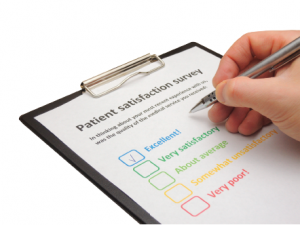
rkjaer / shutterstock.com
You see a patient for the first time to establish care for Sjögren’s disease. She complains of dry eyes, dry mouth and diffuse arthralgias. You do not appreciate any synovitis on physical exam. Of note, you are the fourth rheumatologist she has seen during the past year. Toward the end of the clinic visit, she requests to be placed on prednisone 60 mg daily, stating it’s the only intervention that helps her pain. Although giving this patient high-dose steroids would make her happy, no clear medical indication exists to do so. After you explain to the patient your reasons for not giving high-dose steroids, the patient states that she is not getting adequate care and that she’s being neglected. After looking at her medical records from her other providers, you realize that this story was replicated with the previous three rheumatologists.
What do you do when a patient’s request interferes with your treatment recommendations?
The Patient–Physician Encounter
Before the 1980s, measurement of patient satisfaction was not included in routine quality assurance evaluations, and that was justified by certain patients’ lack of necessary scientific knowledge. In addition, methods to measure patient satisfaction were not available at that time.1
More than 20 years ago, a physician, Aaron Lazare, conceptualized the clinical encounter between physician and patient as a process of negotiation.2 Per Dr. Lazare, “Patients are conceived as appearing with one or more requests. … It’s the clinician’s task to elicit the request, collect the relevant clinical data, and enter into a negotiation that should foster a relationship of mutual influence between patient and clinician.”2
In those times, patients viewed physicians as a source of unlimited knowledge and wisdom. Over time, the perception of the clinical encounter as a two-way exchange became more accepted, mostly because of the hypothesis that encouraging patient involvement in healthcare decision making results in better health outcomes.2
In the late 1980s and early 90s, patient satisfaction gained widespread recognition and became an integral part of outcome measures for health services.
Patient Satisfaction Scores
When the concept of patient-centered care emerged, more emphasis was placed on individual patient preferences, needs and values, and ensuring that patient values guide all clinical decisions. It also includes improving health literacy through patient education, coordination and integration of care, all of which are factors in the concept of shared decision making.3,4
Hospitals invest a considerable amount of time, effort and money to improve patient satisfaction scores. The question then becomes, to what extent do patient satisfaction scores reflect the quality of care provided by physicians? The results of studies that investigate this question are conflicting. Some have shown that patient satisfaction scores correlate with the quality of care provided, while others have not.5,6
A recent study by Jerant and colleagues concluded that clinician denial of certain patient requests, such as referrals, pain medication, other new medications and laboratory testing, were associated with lower clinician satisfaction. Jerant also advocated that “in an era of patient satisfaction-driven compensation, the findings suggest the need to train clinicians to deal effectively with requests.”7
An overemphasis on patient satisfaction may have unintended adverse effects, such as promoting opioid addiction & overutilization of healthcare resources.
Satisfaction = Improved Outcomes?
Although patient satisfaction scores are meant to improve outcomes, there may be unexpected consequences. In a society with a healthcare system in which no incentives are based on patient satisfaction, medicine is practiced with the primary goal of decreasing morbidity and mortality. In a world where patients are asked to fill out surveys reflecting their satisfaction with staff members, practicing medicine becomes customer service driven, and patient satisfaction may be prioritized over evidence-based medicine. In the end, the patient may be the victim.
The critical difference between delivering healthcare services and other customer-based services is that in the latter, the individual requesting the service is the same one paying for it. In the former, the patients request services and insurances pay for those services. In this situation, some patients may overutilize resources. The role of the treating physician is to apply evidence-based medicine and decline inappropriate patient requests.
Clinic visits are now shorter, and physicians feel pressured to do more in less time while maintaining mutual respect with their patients. With the encouragement of patient involvement in decision making, patients feel they have more ownership of their health and may ask their physicians for more diagnostic testing or referrals. Some of those requests may be inappropriate because of the lack of a clear medical indication and overutilization of resources and time. Even when the request is not indicated, saying “no” may compromise the patient–provider relationship. But does saying “yes” to an inappropriate request do more harm than good?
The Centers for Medicare and Medicaid Services (CMS) link payment to achieving the triple aim initiative: better patient experiences, better health and lower cost.8 Prior studies have shown that physician refusal of opioid prescription requests was associated with worse patient satisfaction scores, so when it comes to chronic pain management, certain fields, such as pain management and rheumatology, will be heavily affected.7 As a result, their patient satisfaction scores may be relatively low compared with other subspecialties.
In the Journal of the American Medical Association (JAMA) Forum, Diana Mason, PhD, RN, provided an example of a financially stressed hospital that encouraged employees to ensure high patient-satisfaction scores to enhance Medicare payments. Employees received customer service training and were compelled to prescribe more opioids to drug-seeking patients and order unnecessary tests per patients’ requests.9 This raises the concern that some hospitals may seek better reimbursement by improving patient satisfaction while jeopardizing other aspects of care.
Do highly satisfied patients receive better care and experience improved health outcomes? In 2012, Fenton et al conducted a four-year nationwide prospective cohort study that included 51,946 patients. Patient satisfaction was measured using the Customer Assessment of Health Plans Survey. The results showed that patients with high satisfaction scores had lower emergency department visits but had higher costs, rate of hospitalization, overall healthcare and prescription drug expenditures, and increased mortality.5
We can also take a look at the other side of this conundrum, which is physicians’ satisfaction with healthcare delivery. Zgierska et al conducted a study in which physicians were asked to provide their perceived effects of patient satisfaction ratings on their job satisfaction and clinical care. Results suggest that patient satisfaction survey utilization may promote, under certain circumstances, job dissatisfaction and inappropriate clinical care among some physicians.10,11
Conclusion
If I get sick, I would rather be treated correctly by healthcare providers having my best interest at heart, even if I am unsatisfied with certain aspects of my hospital experience, than be satisfied and die in the hospital from inappropriate care.
While patient satisfaction reports may reflect physicians’ interpersonal communication skills and help achieve the goal of patient-centered care, an overemphasis on patient satisfaction may have unintended adverse effects, such as promoting opioid addiction and overutilization of healthcare resources. Therefore, patient satisfaction reports should be used with caution.
 Zineb Aouhab, MD, RhMSUS, is an assistant professor in the department of rheumatology at Loyola University Medical Center in Maywood, Illinois. She is a member of the ACR’s Committee on Ethics and Conflict of Interest.
Zineb Aouhab, MD, RhMSUS, is an assistant professor in the department of rheumatology at Loyola University Medical Center in Maywood, Illinois. She is a member of the ACR’s Committee on Ethics and Conflict of Interest.
References
- Vuori H. Patient satisfaction—an attribute or indicator of the quality of care? QRB Qual Rev Bull. 1987 Mar;13(3):106–108.
- Carroll JG, Frankel RM, Keller A, et al (editors). The Medical Interview: Clinical Care, Education, and Research. Chapter 4: The interview as a clinical negotiation. Lazare A. (1995) New York: Springer-Verlag. pp 50–62.
- Epstein RM, Street RL Jr. The values and value of patient-centered care. Ann Fam Med. 2011 Mar–Apr;9(2):100–103.
- Kupfer JM, Bond EU. Satisfaction and patient-centered care necessary but not equal. JAMA. 2012 Jul 11;308(2):139–140.
- Fenton JJ, Jerant AF, Bertakis KD, Franks P. The cost of satisfaction. A national study of patient satisfaction, health care utilization, expenditures, and mortality. Arch Intern Med. 2012 Mar 12;172(5):405–411.
- Xiang X, Xu WY, Foraker RE. Is higher patient satisfaction associated with better stroke outcomes? Am J Manag Care. 2017 Oct 1;23(10):e316–e322.
- Jerant A, Fenton JJ, Kravitz RL, et al. Association of clinician denial of patient requests with patient satisfaction. JAMA Intern Med. 2018 Jan 1;178(1):85–91.
- Whittington JW, Nolan K, Lewis N, Torres T. Pursuing the Triple Aim: The first 7 years. Milbank Q. 2015 Jun;93(2):263–300.
- Mason D. Does linking payment to patient satisfaction harm or help? JAMA Forum. 2015 Jun 17.
- Zgierska A, Rabago D, Miller MM. Impact of patient satisfaction ratings on physicians and clinical care. Patient Prefer Adherence. 2014 Apr 3;8:437–446.
- Zgierska A, Miller M, Rabago D. Patient satisfaction, prescription drug abuse, and potential unintended consequences. JAMA. 2012 Apr 4;307(13):1377–1378.
